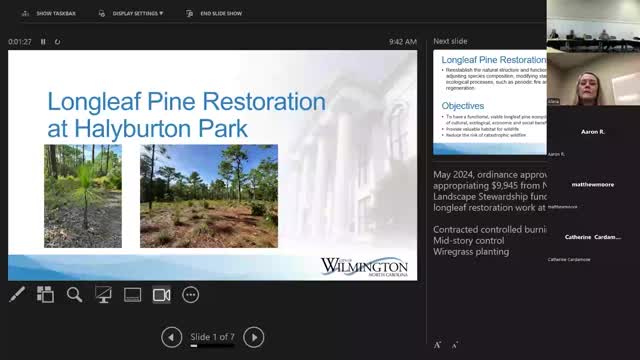Restoration project aims to revive endangered longleaf pine forests
September 18, 2024 | Wilmington, New Hanover County, North Carolina
This article was created by AI summarizing key points discussed. AI makes mistakes, so for full details and context, please refer to the video of the full meeting. Please report any errors so we can fix them. Report an error »

In a recent government meeting, officials discussed the ongoing restoration efforts of the longleaf pine forest at Halyburton Park, emphasizing the ecological significance and the challenges posed by a century of fire suppression. The longleaf pine forest, classified as a unique variant of sandhill scrub coastal plain, is characterized by its open woodland canopy and dense grassy herbaceous layer. However, without regular fire, the midstory has become dense, inhibiting the growth of longleaf pine and the herbaceous layer.
The restoration project aims to reintroduce fire as a natural process essential for the health of these ecosystems. Controlled burns, along with physical methods such as thinning turkey oaks, are planned to restore the forest's structure and dynamics. The project has received funding of nearly $10,000 from the National Fish and Wildlife Foundation, which supports efforts to restore longleaf pine forests across their historic range.
Currently, approximately 5 million acres of longleaf pine remain, a stark contrast to the 90 million acres that existed at European settlement. The restoration efforts at Halyburton Park have already seen the completion of 12 acres of midstory reduction, with plans for further work to enhance biodiversity and reduce the risk of catastrophic wildfires.
Public engagement is a key component of the project, with educational initiatives and events planned to inform the community about the restoration process and its importance. The upcoming Fire and the Pines Festival aims to further engage the public and promote awareness of the ecological benefits of the longleaf pine forest.
Officials highlighted the long-term vision of creating a fully functioning longleaf pine ecosystem that not only supports wildlife but also provides recreational opportunities for the community. The restoration efforts are seen as vital for preserving this endangered forest type for future generations.
The restoration project aims to reintroduce fire as a natural process essential for the health of these ecosystems. Controlled burns, along with physical methods such as thinning turkey oaks, are planned to restore the forest's structure and dynamics. The project has received funding of nearly $10,000 from the National Fish and Wildlife Foundation, which supports efforts to restore longleaf pine forests across their historic range.
Currently, approximately 5 million acres of longleaf pine remain, a stark contrast to the 90 million acres that existed at European settlement. The restoration efforts at Halyburton Park have already seen the completion of 12 acres of midstory reduction, with plans for further work to enhance biodiversity and reduce the risk of catastrophic wildfires.
Public engagement is a key component of the project, with educational initiatives and events planned to inform the community about the restoration process and its importance. The upcoming Fire and the Pines Festival aims to further engage the public and promote awareness of the ecological benefits of the longleaf pine forest.
Officials highlighted the long-term vision of creating a fully functioning longleaf pine ecosystem that not only supports wildlife but also provides recreational opportunities for the community. The restoration efforts are seen as vital for preserving this endangered forest type for future generations.
View full meeting
This article is based on a recent meeting—watch the full video and explore the complete transcript for deeper insights into the discussion.
View full meeting
